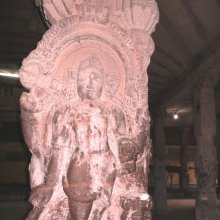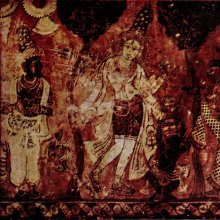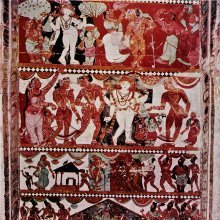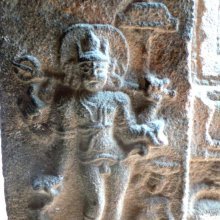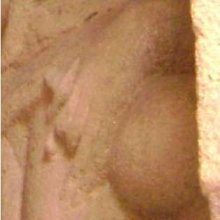Bhikshatana, Bhikṣāṭana, Bhiksha-atana: 17 definitions
Introduction:
Bhikshatana means something in Hinduism, Sanskrit, Marathi, Hindi. If you want to know the exact meaning, history, etymology or English translation of this term then check out the descriptions on this page. Add your comment or reference to a book if you want to contribute to this summary article.
The Sanskrit term Bhikṣāṭana can be transliterated into English as Bhiksatana or Bhikshatana, using the IAST transliteration scheme (?).
Images (photo gallery)
In Hinduism
Shilpashastra (iconography)
Source: Archaeological Survey of India: Śaiva monuments at Paṭṭadakal (śilpa)Bhikṣāṭana (भिक्षाटन) is found as a sculpture at the temple of Lokeśvara, northern façade of the north wall, western half.—Here is a beautiful image of Śiva but, to our bad luck, it is very much damaged. Except his dishevelled hair and the pose, it is difficult to identify what are the attributes and what the image must have been. From the existing faint traces of attributes, with much precaution, we can identify it with Kaṅkālamūrti. A gaṇa is there at his right foot. As the image here is much worn out, we go to the next sculpture.
Source: Shodhganga: Iconographical representations of Śiva (shilpa)1) Bhikṣāṭana (भिक्षाटन) or Bhikṣāṭanamūrti refers to one of the twenty-eighth forms (mūrti) of Śiva mentioned in the Vātulāgama: twenty-eighth among the Siddhāntaśaivāgama. The forms of Śiva (e.g., Bhikṣāṭana) are established through a process known as Sādākhya, described as a five-fold process of creation.
2) Bhikṣāṭana is also listed among the eighteen forms (mūrti) of Śiva mentioned in the Kāraṇāgama (pratimālakṣaṇavidhi-paṭala): the fourth among the Siddhāntaśaivāgamas.
3) Bhikṣāṭana is also listed among the twelve forms (mūrti) of Śiva mentioned in the Suprabhedāgama: the tenth among the Siddhāntaśaivāgamas.
4) Bhikṣāṭana is also listed among the sixteen forms (mūrti) of Śiva mentioned in the Dīptāgama: the sixth among the Siddhāntaśaivāgamas.
5) Bhikṣāṭana is also listed among the eighteen forms (mūrti) of Śiva mentioned in the Śilparatna (twenty-second adhyāya): a technical treatise by Śrīkumāra on Śilpaśāstra.
Source: Shodhganga: The significance of the mūla-beras (śilpa)Bhikṣāṭana (भिक्षाटन) or Śrī Bhikṣāṭana is depicted in the Thillai Nataraja Temple in Cidambaram (Chidambaram) which is one of the Pañcasabhā or “five halls where Śiva is said to have danced”.— Bhikṣāṭana Mūrti is found in standing posture with four hands. The upper right hand holds ḍamaru in kaṭaka-hasta. The upper left hand holds triśūla/mṛga in kaṭaka-hasta. The lower right hand is in dolā-hasta as if touching the mouth of the antelope, and the lower left hand is in vismaya-hasta holding a skull. In dance Bhikṣāṭana Mūrti is portrayed as standing in samapāda-sthānaka with four hands. The upper hands are in kapittha-hasta. The lower right hand is in dolā and the lower left hand is in kuvi-patāka/alapadma. In this sannidhi Vyāgrapāda and Patañjali are found on the either side of the lord.
Bhikṣāṭana is also depicted in the Adi Kumbeswarar Temple (Ādi Kumbheśvara) in Kumbakonam (Kumbhakonam).—Bhikṣāṭana-mūrti is found in standing posture with four hands. The upper right hand holds ḍamaru in kaṭaka-hasta. The upper left hand holds mṛga in kaṭaka-hasta. The lower right hand is in dolā-hasta as if touching the mouth of the antelope and the lower left hand is in vismaya-hasta holding a skull. In dance Bhikṣātana-mūrti is portrayed as standing in samapāda-sthānaka with four hands. The upper right and left hand are in kapittha-hasta. The lower right hand is in dolā and the lower left hand is in kuvi-patāka/alapadma. A bhuta-gaṇa is found to the left of the lord holding a vessel on his head with both his hands.

Shilpashastra (शिल्पशास्त्र, śilpaśāstra) represents the ancient Indian science (shastra) of creative arts (shilpa) such as sculpture, iconography and painting. Closely related to Vastushastra (architecture), they often share the same literature.
Purana and Itihasa (epic history)
Source: archive.org: Shiva Purana - English TranslationBhikṣāṭana (भिक्षाटन) refers to one “wandering and begging for alms”, and is used to describe Śiva, according to the Śivapurāṇa 2.2.29. Accordingly as Brahmā narrated to Nārada:—“[...] Satī addressed Viṣṇu and others severally, taunting them. Satī said:—‘[...] Once the lord wandered (begging for alms) [viz., bhikṣāṭana] in Dāruvana. You, sages, cursed him in the guise of a mendicant. How is it that you have now forgotten what Śiva did on being cursed by you? The entire universe of the mobile and immobile was burnt by His Liṅga’”.

The Purana (पुराण, purāṇas) refers to Sanskrit literature preserving ancient India’s vast cultural history, including historical legends, religious ceremonies, various arts and sciences. The eighteen mahapuranas total over 400,000 shlokas (metrical couplets) and date to at least several centuries BCE.
Languages of India and abroad
Marathi-English dictionary
Source: DDSA: The Molesworth Marathi and English Dictionarybhikṣāṭana (भिक्षाटन).—n (S) pop. bhikṣāṭaṇa n Wandering about begging alms, mendicity or mendicancy.
Source: DDSA: The Aryabhusan school dictionary, Marathi-Englishbhikṣāṭana (भिक्षाटन) [-ṇa, -ण].—n Wandering about begging alms, mendicancy.
Marathi is an Indo-European language having over 70 million native speakers people in (predominantly) Maharashtra India. Marathi, like many other Indo-Aryan languages, evolved from early forms of Prakrit, which itself is a subset of Sanskrit, one of the most ancient languages of the world.
Sanskrit dictionary
Source: DDSA: The practical Sanskrit-English dictionaryBhikṣāṭana (भिक्षाटन).—wandering about begging for alms; रुद्रो येन कपालपाणिपुटके भिक्षाटनं कारितः (rudro yena kapālapāṇipuṭake bhikṣāṭanaṃ kāritaḥ) Bhartṛhari 2.95.
-naḥ a beggar, mendicant.
Derivable forms: bhikṣāṭanam (भिक्षाटनम्).
Bhikṣāṭana is a Sanskrit compound consisting of the terms bhikṣā and aṭana (अटन).
Source: Cologne Digital Sanskrit Dictionaries: Shabda-Sagara Sanskrit-English DictionaryBhikṣāṭana (भिक्षाटन).—n.
(-naṃ) Begging, mendicancy. m.
(-naḥ) A mendicant. E. bhikṣā alms, and aṭana going about for.
Source: Cologne Digital Sanskrit Dictionaries: Benfey Sanskrit-English DictionaryBhikṣāṭana (भिक्षाटन).—n. wandering about for begging alms, [Pañcatantra] 116, 17.
Bhikṣāṭana is a Sanskrit compound consisting of the terms bhikṣā and aṭana (अटन).
Source: Cologne Digital Sanskrit Dictionaries: Cappeller Sanskrit-English DictionaryBhikṣāṭana (भिक्षाटन).—[neuter] the same; naṃ kṛ beg for alms.
Source: Cologne Digital Sanskrit Dictionaries: Aufrecht Catalogus Catalogorum1) Bhikṣāṭana (भिक्षाटन) as mentioned in Aufrecht’s Catalogus Catalogorum:—from Brahmāṇḍapurāṇa. Burnell. 203^b.
2) Bhikṣāṭana (भिक्षाटन):—a poet. Śp. p. 65.
Source: Cologne Digital Sanskrit Dictionaries: Monier-Williams Sanskrit-English Dictionary1) Bhikṣāṭana (भिक्षाटन):—[from bhikṣā > bhikṣ] mfn. (kṣāṭ) idem, [cf. Lexicographers, esp. such as amarasiṃha, halāyudha, hemacandra, etc.]
2) [=bhikṣā-ṭana] [from bhikṣāṭana > bhikṣā > bhikṣ] m. Name of a poet, [Catalogue(s)]
3) [v.s. ...] n. wandering about for alms, mendicancy, [Kāvya literature; Purāṇa] etc. ([accusative] with √kṛ, to go about begging, [Pañcatantra]; with [Causal] of √kṛ, to cause to go about begging, [ib.])
4) [v.s. ...] Name of [chapter] of [Brahmāṇḍa-purāṇa]
Source: Cologne Digital Sanskrit Dictionaries: Yates Sanskrit-English DictionaryBhikṣāṭana (भिक्षाटन):—[bhikṣā+ṭana] (naṃ) 1. n. Begging.
[Sanskrit to German]
Sanskrit, also spelled संस्कृतम् (saṃskṛtam), is an ancient language of India commonly seen as the grandmother of the Indo-European language family (even English!). Closely allied with Prakrit and Pali, Sanskrit is more exhaustive in both grammar and terms and has the most extensive collection of literature in the world, greatly surpassing its sister-languages Greek and Latin.
Hindi dictionary
Source: DDSA: A practical Hindi-English dictionaryBhikṣāṭana (भिक्षाटन):—(nm) going about begging.
...
Kannada-English dictionary
Source: Alar: Kannada-English corpusBhikṣāṭana (ಭಿಕ್ಷಾಟನ):—[noun] = ಭಿಕ್ಷಾಟನೆ [bhikshatane].
Kannada is a Dravidian language (as opposed to the Indo-European language family) mainly spoken in the southwestern region of India.
See also (Relevant definitions)
Partial matches: Bhiksha, Atana, Tana.
Starts with: Bhikshatanakavya, Bhikshatanamgey, Bhikshatanamurti, Bhikshatananataka, Bhikshatanapratishtha.
Full-text (+5): Bhikshatanakavya, Bhikshatananataka, Atana, Bhikshatanamurti, Bhikshayana, Pitcatanam, Kantiyur, Putaka, Bhikshatanapratishtha, Mohini, Pitcatanar, Purari, Candrashekharasthapana, Sharabheshapratishtha, Lingodbhavapratishtha, Dakshinamurtipratishtha, Balibhartripratishtha, Somaskandasthapana, Puraristhapana, Rajasa.
Relevant text
Search found 9 books and stories containing Bhikshatana, Bhikṣāṭana, Bhiksatana, Bhiksha-atana, Bhikṣā-aṭana, Bhiksa-atana, Bhiksha-tana, Bhikṣā-ṭana, Bhiksa-tana; (plurals include: Bhikshatanas, Bhikṣāṭanas, Bhiksatanas, atanas, aṭanas, tanas, ṭanas). You can also click to the full overview containing English textual excerpts. Below are direct links for the most relevant articles:
Kashyapa Shilpa-shastra (study) (by K. Vidyuta)
7. Favourable Directions for Installing the Śiva Mūrtis < [Chapter 3 - Prākāra Lakṣaṇa]
The Religion and Philosophy of Tevaram (Thevaram) (by M. A. Dorai Rangaswamy)
Introduction < [Volume 3.6 - Pilgrim’s progress: away from Otriyur and Cankili]
Chapter 32 - Thirumudhukundram or Tirumutukunram (Hymn 43) < [Volume 3.3 - Pilgrim’s progress: to Chola (later?)]
Chapter 65 (a) - Thiruvottriyur or Tiruvorriyur or Tiruvottiyur (Hymn 91) < [Volume 3.5 - Pilgrim’s progress: to the North]
Cosmetics, Costumes and Ornaments in Ancient India (by Remadevi. O.)
2.5. Various other Hand Ornaments < [Chapter 3 - Ornaments]
Sculpture at its Best < [September-October, 1929]
Translation of Oral Literature < [October – December, 2002]
The Golden Age of Hindu-Javanese Art < [September-October 1931]
Atithi or Guest Reception (study) (by Sarika. P.)
Part 3 - Atithi-saparyā in Āraṇyakas < [Chapter 2 - Ātithyeṣṭi]
Pallava period (Social and Cultural History) (by S. Krishnamurthy)
Ornamental Diagonal Band across the Body < [Chapter 4 - Material Culture of the People]
Shaivism during the Pallava period < [Chapter 3 - Socio-Religious Life]
Household Articles (a): Vessel < [Chapter 4 - Material Culture of the People]
Related products
